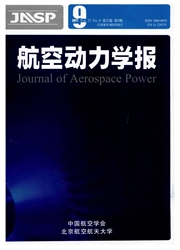

 中文摘要:
中文摘要:
采用标准k-ε湍流模型、涡耗散湍流燃烧模型、P-1辐射传热模型对二维简化燃烧室燃料甲烷气、沼气、生物质气的燃烧特性进行了数值模拟.通过比较不同截面的燃烧情况,分析燃烧室内的温度分布、NOx质量分数分布、流场结构,研究了不同热值燃料的燃烧特性.结果表明:在入口空气、燃料质量流量相同的条件下,随着燃料热值降低,燃烧温度降低,温度分布更均匀,NOx排放量减少,流动速度降低;适当调节余气系数,能改善燃烧效果,温度分布仍满足高热值燃料燃烧温度高于低热值燃料燃烧温度的规律;在生物燃料混合气中掺入不同热值的可燃成分,可改变混合气的热值,恰当的混合比例能更好地发挥生物燃料的作用.
 英文摘要:
英文摘要:
Combustion characteristics of the two-dimensional simplified combustor were simulated numerically for methane, marsh gas and biomass gas, with introduction of stand- ard κ-ε turbulence model, eddy-dispassion turbulence combustion model and P-1 radiation heat transfer model. The temperature distribution, NOx mass fraction distribution, flow field structure in the combustor were analyzed to obtain the combustion characteristics of fu- els with different calorific values by comparing the combustion situations of different cross sections. Results show that, under the condition of same mass flow of inlet air and fuel, the combustion temperature decreases with the decline of calorific value of fuels, the temperature distribution is more uniform, the NOx emissions are diminished, and the flow velocity is re- duced~ the proper regulation of excess air coefficient can improve the effect of combustion burning, and the temperature distribution still meets the law that combustion temperature of fuels with high calorific value is higher than that of fuels with low calorific value; the mixing of combustible components with different calorific values in biofuels syngas will change the calorific value of syngas, and the appropriate mixing ratio can play a better role for biofuels.
 同期刊论文项目
同期刊论文项目
 同项目期刊论文
同项目期刊论文
 期刊信息
期刊信息
